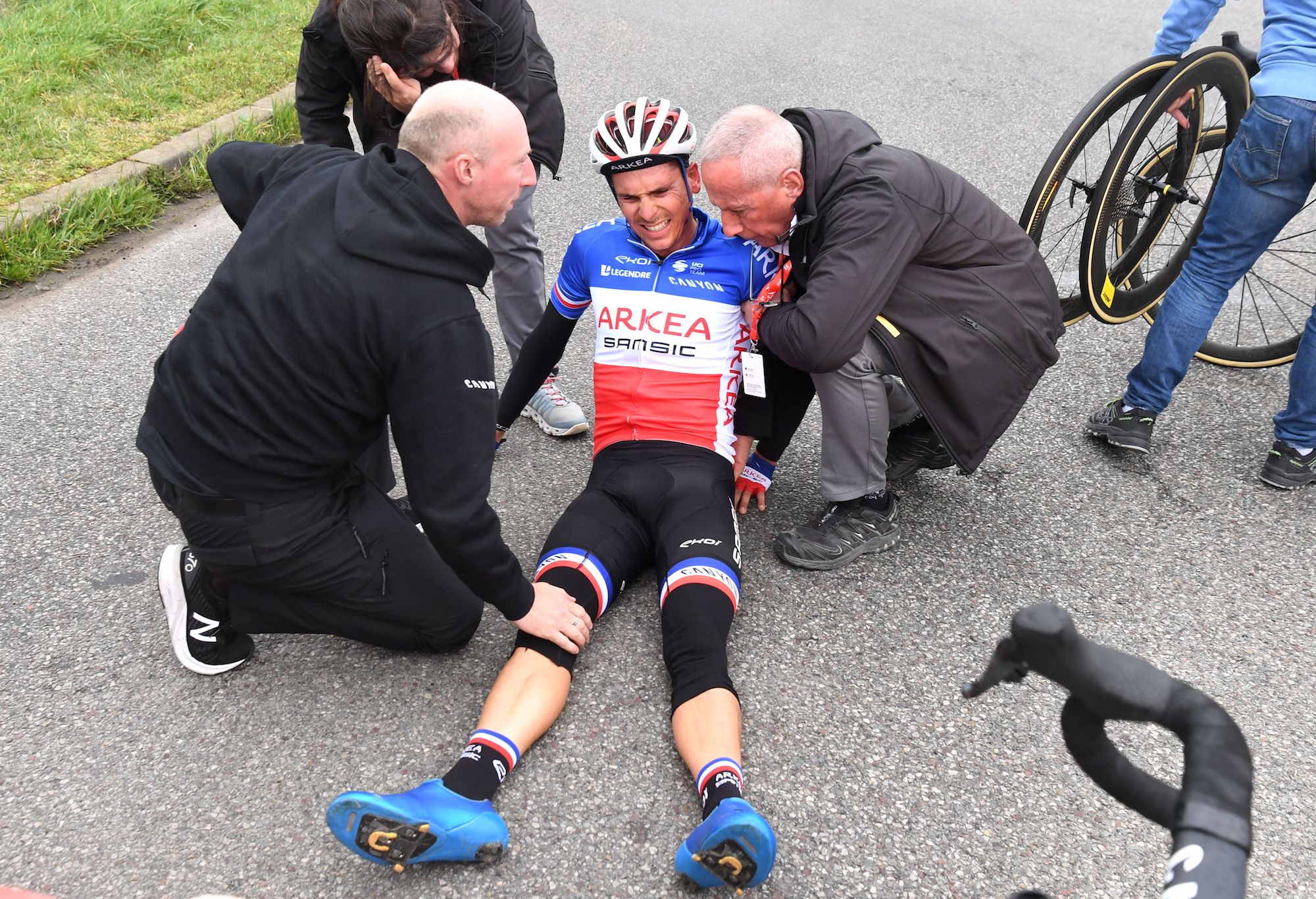'The rule is bent in most races': Should Warren Barguil have been disqualified from Paris-Nice?
Barguil’s disqualification on the opening day of Paris-Nice once again threw a focus on drafting behind team cars

Warren Barguil after crashing during stage one of Paris-Nice 2020 (Alain Jocard/AFP via Getty Images)
Diverting very briefly away from the current coronavirus crisis, something has been nagging at me over the past few days…
On the opening stage of Paris-Nice, French champion Warren Barguil was disqualified for drafting behind an Arkéa-Samsic team car.
“Un peu groggy,” as the result of a crash on a roundabout that had also seen Romain Bardet go down, Barguil, who had been checked out for a concussion injury before he got back on his bike, spent quite a time behind the vehicle trying to decide whether he was okay to continue racing or whether he should abandon.
In the end, he decided he could go on and rolled in dead last, more than quarter of an hour behind stage winner Max Schachmann. He quickly discovered, though, that the race was over anyway because the commissaires had disqualified him.
Barguil and his team’s managers accepted the decision, the Frenchman even going so far as to encourage fans not to direct any vitriolic messages at the race judges because they were simply doing their job and implementing road racing’s rules. The rule in question is 2.5.022 in the UCI’s regulations, which states that: “The riders that have dropped behind may under no circumstances ride in the slipstream of a vehicle.”
It seems a reasonable rule, but you don’t have to watch bike racing for very long to realise that it’s often bent in most races. Riders who crash and are dropped, like Barguil did, frequently get back up to speed and to the peloton with some motor-paced assistance.

Barguil’s disqualification naturally evoked comparisons with that of Nils Eekhoff at the World Championships last September after the Dutch rider had won the U23 road race with a scintillating late charge up the hill to the line in Harrogate.
The latest race content, interviews, features, reviews and expert buying guides, direct to your inbox!
Eekhoff had crashed heavily early in the race and, like the Frenchman, had waited to have a concussion check-up from a doctor before rejoining the action. In the immediate aftermath of the Eekhoff’s victory, footage emerged that showed him drafting behind a Dutch team car for more than two minutes, often at very high speeds. It’s worth noting, too, that USA’s Katie Clouse was disqualified from the junior road race earlier in the championships for contravening the same rule.
According to a UCI spokesperson in Harrogate, an increase in the number of in-race cameras has enabled commissaires to crack down on infringements of the drafting rule and that teams at the Worlds and other races had been informed that they would be doing so.
However, based on the disqualifications of Barguil and Eekhoff, an invisible clause appears to have been added to rule 2.5.022, one that allows drafting for short periods but penalises longer stints behind vehicles. In short, the rule appears to be clear, but implementation is not, leaving riders and fans nonplussed to say the least.
Last October, the professional teams’ organisation, the AIGCP, highlighted its disquiet with implementation of the sport’s rules, stating in an open letter that “the UCI’s most important role, to be a consistent and fair arbiter of the sport and guardian of its safety, is not being performed to any requisite standard.” The Eekhoff affair was seen as a clear case to support this argument.
Thanks to the advent of more and better technology, cycling appears to have entered a similar realm to football, where it is enabling closer analysis of incidents, but often resulting in no clear consensus about whether the right decision has been made or not. Should Barguil and Eekhoff have been disqualified? Yes, according to the rules, but why aren’t so many others?
If, as most riders and teams insist, some leeway should be allowed, especially in cases where a fallen racer has undergone a medical check-up, should lenience be shown in some cases? Does the rule need a rewrite?
I don’t know the answers to these questions, but as a fan and a journalist, I’d just like to see some clarity and consistency in the application of this rule relating to drafting.
Peter Cossins has been writing about professional cycling since 1993, with his reporting appearing in numerous publications and websites including Cycling Weekly, Cycle Sport and Procycling - which he edited from 2006 to 2009. Peter is the author of several books on cycling - The Monuments, his history of cycling's five greatest one-day Classic races, was published in 2014, followed in 2015 by Alpe d’Huez, an appraisal of cycling’s greatest climb. Yellow Jersey - his celebration of the iconic Tour de France winner's jersey won the 2020 Telegraph Sports Book Awards Cycling Book of the Year Award.